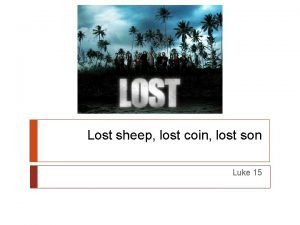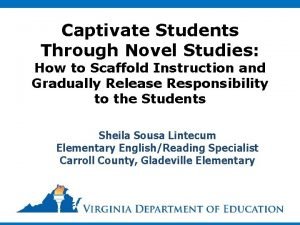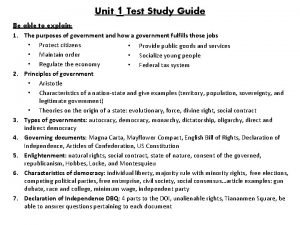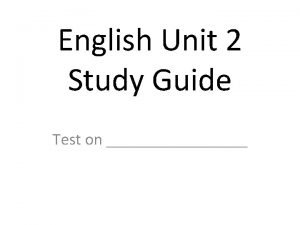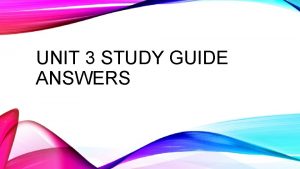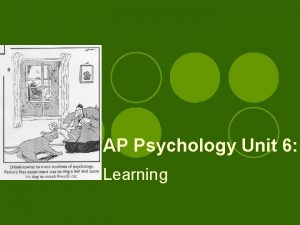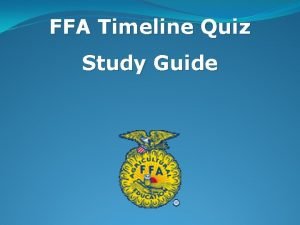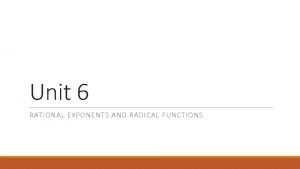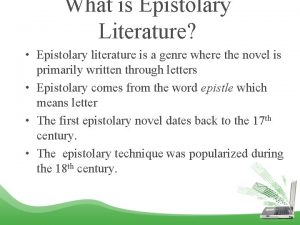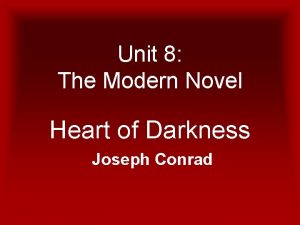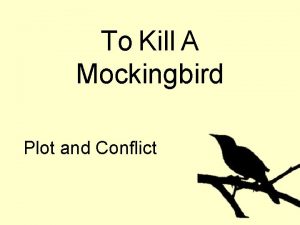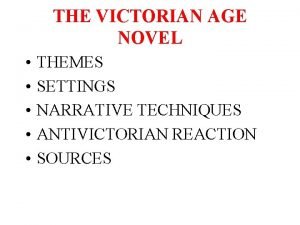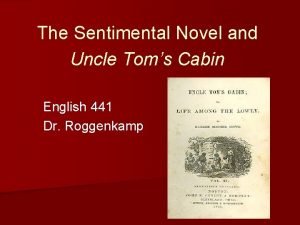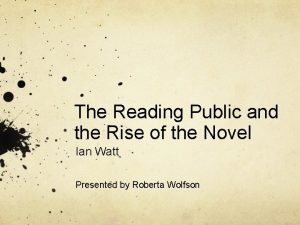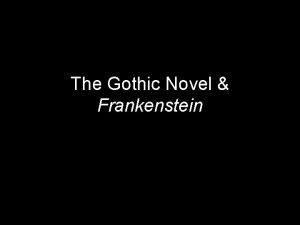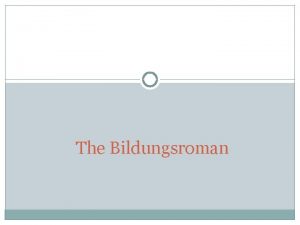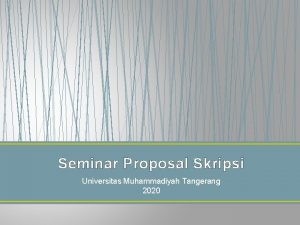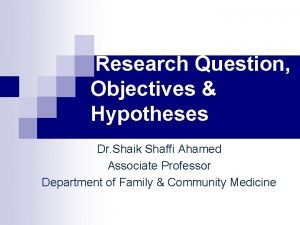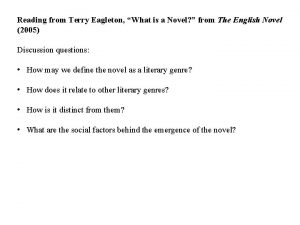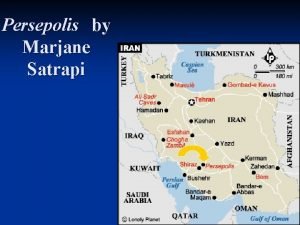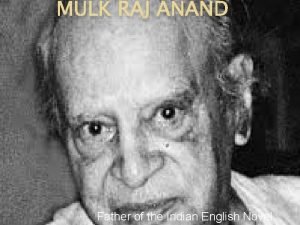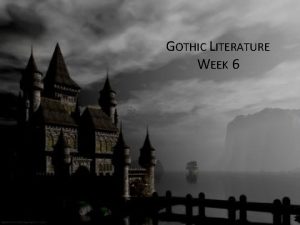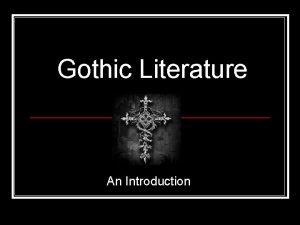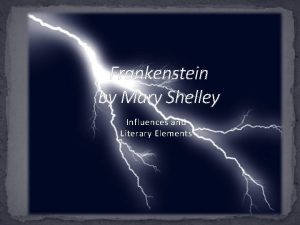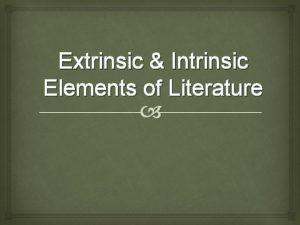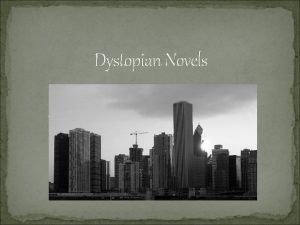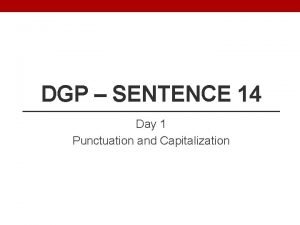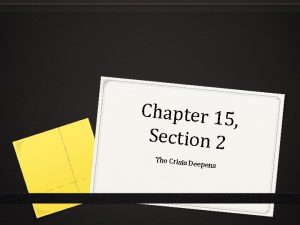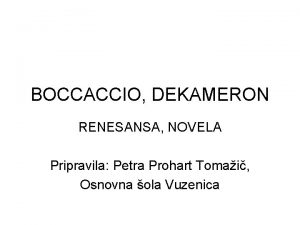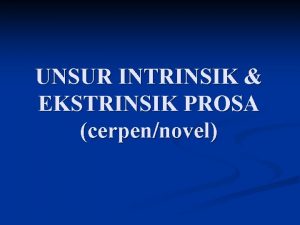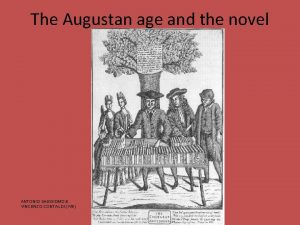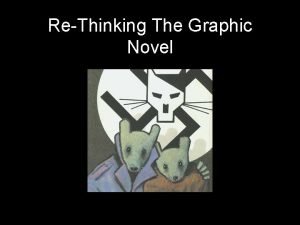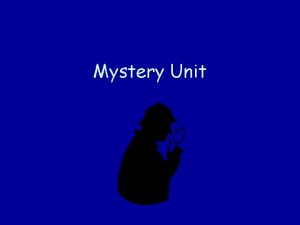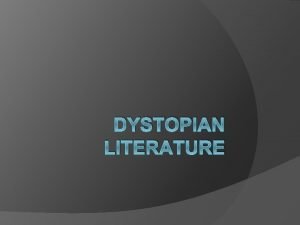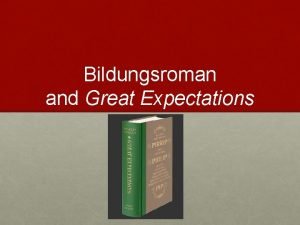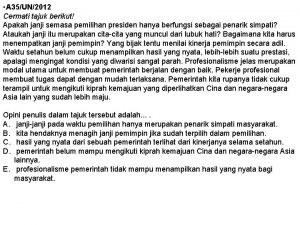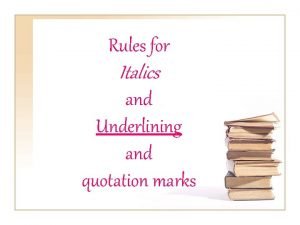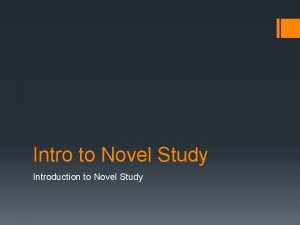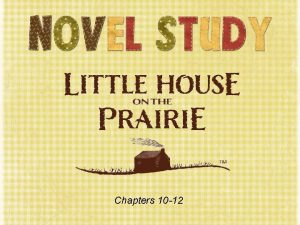Novel Study Unit LOST HORIZON Lost Horizon Chapter































































































- Slides: 95


Novel Study Unit: LOST HORIZON

Lost Horizon Chapter Summaries

SHORT PLOT / CHAPTER SUMMARY (Synopsis)

SHORT PLOT / CHAPTER SUMMARY (Synopsis) The narrator reads a manuscript written by Rutherford telling the story of four travelers’ experiences, after being hijacked, in a mysterious valley known as Shangri-La. Conway, the main character of the four, falls in love with the Valley of Blue Moon and eventually is named the new High Lama. Barnard and Miss Brinklow also find happiness in staying there. Only Mallinson desperately wants to leave and his negativity creates an Imbalance there for all the characters. Eventually, Conway agrees to lead him out of the valley, but he is the only one who survives the trip. Then, once he overcomes amnesia, Conway disappears again in a bid to return to the paradise he had come to love. In the end, the narrator and Rutherford come to believe in the existence of Shangri-La and desperately hope that Conway finds his way there again.

Prologue Abstract • The story of the LOST HORIZON begins in a social meeting of some old classmates who all knew Hugh Conway while in school. • It appears that each of them was more affected by having known Conway than they consciously realized.

Prologue The prologue lays down the background to how the narrator comes across a manuscript which reveals something mysterious concerning Conway and later, Rutherford. There are many strange events connected to Conway: Ø first, the plane that is stolen; Ø second, the Chopin piano piece which no one has ever heard; third, the loss of Conway’s memory and its return after he plays the piano; Ø and finally, Conway’s strange story and his stranger decision to catch a boat to Fiji and head northwest. All of these events are foreshadowing for the manuscript that the narrator is about to read.

Prologue: In Depth Summary The narrator, a neurologist, opens the novel with this prologue; where he explains that he, a writer named Rutherford, an Embassy secretary named Wyland Tertius, and a stranger to the narrator named Sanders, a pleasant young pilot, have all sat down for cigars after dinner at Templelhof. The first three, he says, are three celibate Englishmen in a foreign capital, Berlin. Sanders, who knows Wyland, joins their party after the first three have already dined. They are sitting in the restaurant watching the Luft-Hansa machines arriving at the aerodome and enjoying the evening.

Prologue: In Depth Summary They all drink a great deal of beer, and then Rutherford questions Sanders about his comment that he had been at Baskul and that something interesting had happened there. Sanders tells them that an Afghan or an Afridi had stolen control of one of their planes and taken off in it. The interesting thing about the event was that the thief never came back. There also were three men on board and one woman missionary. One of the men is “Glory” Conway, a name that Rutherford first mentions. The narrator asks Sanders why it was never in the papers, and Sanders says he has given out more information than he was supposed to, because the event was “hushed up. ”

Prologue: In Depth Summary Wyland had stepped away from the table before Sanders told this information, so when he returns, Sanders reveals what he has said and asks Wyland whether it matters that he said it. Wyland seems somewhat offended that the pilot gave away this information and snubs him a bit. However, he willingly discusses Conway and how Rutherford knew him. Then, they all decide to make it an evening. Rutherford suggests that since the narrator is not leaving until very early in the morning that he spend the time in his hotel. They can talk in his sitting room.

Prologue: In Depth Summary They spend the time discussing Conway who had evidently left a significant impression on them both. Rutherford reveals that he had already heard about the affair at Baskul and had thought it only a myth. He also says that since he has traveled a great deal around the world, he has seen strange things, a comment that confuses the narrator. Then, Rutherford reveals that Conway isn’t dead, because he had traveled with him on a Japanese liner from Shanghai to Honolulu the November before. While he was on the Pekin express, he had spoken to a Mother Superior of some French Sisters of Charity. She had mentioned that a fever case had shown up at the mission hospital at Chung. Kiang, a European male with no papers and unable to give any account of himself. He spoke fluent Chinese and French and English with a refined accent. Rutherford had found this hard to believe and politely bid the nun good-bye.

Prologue: In Depth Summary Ironically, he found himself right back at Chung-Kiang when the train broke down a mile or two farther on the track. He decided to take the Mother Superior up on her offer to visit her mission. They prepared a meal for him, and a young Chinese Christian doctor sat down with Rutherford. They also took him for a tour of the hospital. When they introduced him to the foreigner she had told him about, he was astonished to discover that the man was Conway. Unfortunately, Conway didn’t remember Rutherford, because he was suffering from amnesia. Rutherford decided to stay there for a few days to try to help Conway recover his memory. He was unsuccessful, but he did make arrangements to take Conway home. Once they were on the Japanese liner, Rutherford spent the time telling Conway as much as he could about his life.

Prologue: In Depth Summary At the port of Yokohama, a new passenger came on board. His name was Sieveking, and he was a concert pianist. He was prevailed upon to give a recital for the passengers with emphasis on Chopin, a musician Sieveking specialized in. After he got up to leave at the end of the recital, Conway sat down at the piano and began to play a rapid, lively piece which drew Sieveking back to the piano in excitement. Conway was unable to tell the pianist what he had been playing, only that he thought it was a Chopin study. Sieveking refused to believe that it was by Chopin, because he knew everything that Chopin had ever written, and he had never heard this piece. Conway then remembered that it had never been published, and that he only knew it himself from meeting a man who had been one of Chopin’s pupils. Many witnesses saw this exchange between the two men and heard Sieveking say that the piece was so important as to be a part of every virtuoso’s repertoire within six months if it were ever published.

Prologue: In Depth Summary The two men promised to meet again and even made arrangements to make some phonograph records of the piece. Rutherford tells the narrator that he often thought it a pity that Conway was never able to keep his promise to Sieveking. That night after the recital, Conway regained his memory. During the next twenty-four hours, Conway told Rutherford everything that had happened to him, and then they had drinks in Rutherford’s cabin about 10: 00 PM the night before they were expected to dock in Honolulu. Rutherford never saw Conway again, because he gave him the slip and joined a crew of a banana boat heading south to Fiji. Three months later, Rutherford received a letter from Conway thanking him for his care, paying him for any expenses Rutherford may have incurred, and telling him that he was about to set out on a long journey to the northwest. That was all he said.

Prologue: In Depth Summary The narrator is most confused about how Conway arrived at Chung-Kiang, and how he lost his memory. Rutherford reveals that after Conway had told his story over those twenty-four hours on the Japanese liner, he had written it all down into a manuscript. He brings it out for the narrator and tells him to read it and make of it whatever he will. The narrator asks if he’s not supposed to believe it. Rutherford says that Tertullian’s phrase “quia impossibile est” ('I believe because it is impossibleabsurd' ) is not a bad argument. Later, Rutherford sends a short note to the narrator saying he was off on his wanderings again would have no settled address for some months. Not surprising to the narrator, Rutherford is heading to Kashmir and then east. Perhaps he believes his own manuscript more than he is willing to admit.

CHAPTER ONE: Notes

CHAPTER ONE: Notes This is the first part of the manuscript Rutherford had written. It reveals that the rumours about the plane being hijacked were true, and that there were three men and one woman on board, one of whom was Conway. The chapter prepares the reader for a mysterious destination somewhere in the mountains to the northeast. It also shows the reader how Conway becomes the character looked to for help and advice as well as bravery, should it be needed. He is the voice of calm and comfort for the other three passengers. Meanwhile, the pilot remains an unknown element of this equation in which they’ve found themselves.

CHAPTER ONE: In Depth Summary The manuscript begins by explaining that the situation begins during the third week in May (probably in 1930) in Baskul, Afghanistan, when events become so precarious that British Air Force machines arrive to evacuate the white residents. A miscellaneous aircraft is also employed, one owned by the Maharajah of Chandapore, to evacuate four passengers: Miss Roberta Brinklow of the Eastern Mission; Henry D. Barnard, an American; Hugh Conway, H. M. Consul; and Captain Charles Mallinson, H. M. Vice-Consul. At the time, Conway is thirty-seven years old and has been at Baskul for two years. He has no idea where he will be sent next which is a precarious characteristic of his profession as a foreign diplomat. He has been working this profession for ten years. He is so tired at the time of the flight from destroying and packing documents that he stretches out in the plane to sleep.

CHAPTER ONE: In Depth Summary About an hour after the flight began, Mallinson notices that the pilot isn’t keeping a straight course. He also notices that the pilot isn’t Fenner, the man they thought would be flying them out. Conway isn’t upset by this possible development, because he isn’t all that eager to go to Peshawar. Then, the plane begins to descend, and when the two men look out the window of the plane, they see an opaque mist veiling an immense sun-brown desolation with long, corrugated mountain ridges and frontier scenery. There looks to be no place to land, but the pilot does so into a small space opened by the side of a gully. That is followed by a swarm of bearded, turbaned tribesmen surrounding the machine and preventing anyone from getting out of it except the pilot. The plane is re-fueled, and then the flight commences again. To the four passengers, it is totally extraordinary and bewildering.

CHAPTER ONE: In Depth Summary Mallinson comes to the conclusion that they are being kidnapped for ransom which in light of the mysterious events seems the most believable of any theories. Conway begins to gather all the scraps of paper he can find to compose a message in as many of the various native languages as he can and then drop them from the plane along the way. It is a slender chance, but one worth taking. Miss Brinklow just sits tight-lipped and straight-backed, while Conway and Barnard determine how easy it would have been to hijack the plane. They all agree that if anyone can get them out of this situation it will be Conway lies half asleep, turning over in his mind whether he is a brave as his companions have judged him. He has, since WWI, been reluctant to face danger unless it promises extravagant dividends in thrills. He just feels an enormous distaste for whatever trouble might be in store for them.

CHAPTER ONE: In Depth Summary The flight continues all afternoon, steadily eastward, but Conway cannot judge where they are headed with any accuracy. Mallinson is eager to smash the panel and demand answers from the pilot, but Conway reminds him that the pilot is armed, and that none of them will know how to bring down the plane if they hurt him. There is nothing for them to do but sleep, which they all manage to find a way to do. Soon, Conway begins to feel the same sensations of shortness of breath that he had experienced once when he had flown in the Swiss Alps. He looks out the window and sees they are flying amidst range upon range of snow-peaks and glaciers.

CHAPTER TWO: In Depth Summary

CHAPTER TWO: In Depth Summary Conway tells the other passengers as they awaken that they are probably still in India, and that they have probably been flying along some river valley, stretching roughly east and west. If his memory suffices, they are probably in the valley of the upper Indus which would have brought them to this spectacular part of the world. He also thinks the mountain they are looking at is probably Nanga Parbat and the range is the Karakorams. He knows there are several passes through these mountains if the pilot intends for them to cross them. Mallinson insists that the kidnapping theory is no longer applicable, because there are no tribes this far that would seek a ransom. Now the purpose of this flight becomes once again even more frightening. Conway has no answers for their fears, but is secretly satisfied that there are still such beautiful places on earth.

CHAPTER TWO: In Depth Summary Dusk soon falls which lowers their spirits once again, and Conway comes to the conclusion that they are heading towards Tibet. Soon, the plane gives a lurch, and they realize that the engines have been turned off, and the plane is rushing against a gale. The pilot then lands the plane badly with crashing and swaying jolts to the passengers and a broken tail-skid. They tear open the cockpit and discover the pilot is unconscious. Conway assumes finally the strong role of the leader, and they lift the man out and down to the ground. Then, they realize that the environment will be dangerous for them all and return the pilot and themselves to the cabin of the plane. Miss Brinklow surprisingly produces a bottle of brandy, and they give the pilot some.

CHAPTER TWO: In Depth Summary Conway now believes that they have flown far beyond the western range of the Himalayas towards the less known heights of the Kuen-Lun. They have reached the loftiest and most inhospitable part of the earth’s surface, the Tibetan plateau. The next day, they take the pilot out of the plane, hoping the sun will revive him, but he becomes weaker and finally dies about mid-morning. The man muttered in his final delirium enough information to let them know that they were in Tibet, and that there is a lamasery nearby called Shangri-la. The dying man had been very emphatic that they go there. They argue about whether this is the best plan for them to follow, but finally come to the conclusion that their best chance of survival is to find humans. Just as they finally all agree to the plan, they see coming down a faraway slope the figures of men.

CHAPTER THREE: Notes

CHAPTER THREE: Notes Much of this chapter is a series of foreshadowing: Ø Conway preferring not to be a leader, but accepting the role anyway; Ø Chang, a Chinese, who speaks perfect English; Ø Chang’s comments that they may not be away from civilization at all and that they will ultimately have no regrets about coming to Shangri. La; Ø seeing a new mountain, Karakal; Conway’s feeling that he has at last found a place which is an end, a finality; Ø and Chang’s explanation for his nap that he has to take care of himself. All of these events indicate that Shangri-La is a mysterious unknown place that will bring all four of these “captives” to discover a world that may or may not bring them peace and happiness.

CHAPTER THREE: In Depth Summary As the four passengers await the arrival of the men in the distance, Conway takes on the role of onlooker, refusing to be drawn into being a leader or being forced to decide what to do or not to do. Then, the figures reveal themselves to be a part of a dozen or more men carrying with them a hooded chair. Inside the chair is a figure robed in blue. Having lived in China for a few years, Conway understands the ritual of meeting and how ceremonial it must be. As a result, he steps forward to follow the proper procedure, and the stranger follows suit and says he is from the lamasery of Shangri-La and his name is Chang. He speaks perfect English and insists that he guide them back to the lamasery. Conway agrees, but Mallinson insists that their stay won’t be long, because they want to return to civilization as soon possible. Chang responds, “Are you so very sure that you are away from it? ” It is a significant comment foreshadowing the future. He further declares that the four passengers will be honorably treated, and that ultimately, they will have no regrets.

CHAPTER THREE: In Depth Summary Chang then sees to it that they have wine and mangoes, a fruit that Conway cannot believe could be cultivated so high in the mountains. Once they are refreshed, the party begins its climb towards the lamasery, viewing a mountain that Conway has never heard of before – Karakal – in the distance. Conway wonders if the lamas have surveyed its height, and Chang only comments that there’s nothing incompatible between monasticism and trigonometry.

CHAPTER THREE: In Depth Summary They walk all morning and into the afternoon, with the air becoming thinner and harder to breathe, while Change sleeps in his chair. They eventually reach the summit of the ridge and then link themselves together with heavy mountaineering ropes in order to be protected as they follow a track consisting of a traverse cut along the flank of a rock wall. The height above it is obscured by the mist, and below is an abyss. Meanwhile, most of the way on this track, Mallinson is begging Conway to decide what they are going to do. Conway replies that there are times in life when the most comfortable thing is to do nothing at all. He reminds the younger man that they may have just exchanged one lunacy for another, given that they have just escaped the torturous nightmare of Afghanistan.

CHAPTER THREE: In Depth Summary Suddenly, being first of the four passengers, Conway sees the lamasery appear out of the mist. It is absolutely superb and exquisite, seeming to hang on the side of the next ridge. Meanwhile, in the valley below, is a delightfully flavored place awash in green. He feels “the deeper sensation, half mystical, half visual, of having reached at last some place that is an end, a finality. ” Chang then awakes and makes the mysterious comment that he has slept, because he “has to take care of himself. ” He indicates that they will be given the opportunity to bathe and refresh themselves, and then he will be honored if they all join him for dinner. Mallinson agrees, but only if Chang will help them make plans for their departure.

CHAPTER FOUR: Notes

CHAPTER FOUR: Notes This chapter is basically a study in the determination of Mallinson to depart from Shangri-La and Conway’s growing fascination with the lamasery. One represents the frustration and the impetuous demands of youth while the other is a study in patience and complacency and even a desire to just find some peace in his life. These two contrasting characters will be the ultimate determiners of the outcome of this story and the lessons the reader will learn in the end: one being fear of the unknown and the other, the search for a meaningful life.

CHAPTER FOUR: In Depth Summary Later that evening as they are all seated at dinner, Chang observes that they are not as uncivilized as the four may have expected. Conway is unable to deny it as he had noticed at his bath that the tub is made of delicate green porcelain made in Akron, Ohio. He readily enjoys the meal, because he likes the Chinese and their ways. Chang eats only a salad and once again explains his behaviour by commenting that he must take care of himself. Conway comments in return that the lamas seem a “very fortunate community, and hospitable to strangers. ” He observes that they must not receive strangers very often, and that a separate culture might flourish there without contamination from the outside world.

CHAPTER FOUR: In Depth Summary Miss Brinklow speaks up and assertively asks Chang to tell them about the monastery. In his ensuing commentary, the reader discovers that there are fifty who are considered full lamas and a few others, including himself, who have not yet obtained full initiation, an amazing piece of information, given that he seems to be elderly although not yet old. He also explains that there are representatives among them from a great many nations, although Tibetans and Chinese make up the majority. When Miss Brinklow, in her missionary attitude, asks him to explain what the lamas believe, he explains that there are many religious beliefs among them, but what they most believe in is moderation. They avoid excesses of all kinds in the valley. Conway observes that Chang applies the idea of moderation to the people of the valley, but is careful not to apply it to the priesthood. When he asks Chang why, the elder man replies that it is a matter which he may not discuss, another mysterious comment about life at the lamasery.

CHAPTER FOUR: In Depth Summary Mallinson continues to question Chang about arranging for porters to lead them out as early as the next day. But Chang says that he is not the proper person to approach about the matter, and that he doesn’t believe the matter can be arranged immediately. Mallinson continues to press the point, trying to get Chang to help them, while Chang is readily amenable to anything Mallinson asks for, including maps, but is short of agreeing to make the arrangements. Chang eventually gets to the point where he just doesn’t answer Mallinson, and the young man, in his anger and anxiety, collapses. Chang blames his collapse on the thin air and insists he will better the next day.

CHAPTER FOUR: In Depth Summary Conway then steps forward to patiently encourage Chang to answer Mallinson’s questions. Because he is so patient and less demanding, Chang observes that he is wiser than his companions and explains that they will not be able to hire men from the valley to be their porters, because they will refuse to leave the valley. Conway also observes to Chang that it was not a chance meeting when Chang and the men had come across their plane and that they must have known beforehand about their arrival. He wonders how? For a moment, Chang shows stress, something that Conway had noticed before. He insists to Conway that none of them are in any danger at Shangri-La, but they may have to face some delay in their departure. Conway is agreeable to a short delay, because he feels so comfortable at the lamasery. As Chang moves to depart from the dinner table, Conway asks him the literal interpretation of Karakal. Chang whispers that it means “Blue Moon. ”

CHAPTER FOUR: In Depth Summary When morning comes, Conway muses on his role at the lamasery now. He thinks about his position as a leader who had safely evacuated the British personnel from Baskul. He feels that it is not a bad achievement, and that gives him comfort. However, he does have some slight worry about whether the others can achieve their departure, given the strangeness of this place. As for himself, the puzzle of Shangri-La is beginning to exercise over him “a charming fascination. ” He is far from grumbling about their situation.

CHAPTER FOUR: In Depth Summary When Mallinson once again inquires of Chang about porters, Chang tells him what he had told Conway the night before: there are no men willing to accompany the group so far from their homes. Conway smoothly intercedes again to avoid any ugliness by asking Chang what he proposes they do. Chang seems to be willing to answer Conway just about anything and offers the suggestion that they wait approximately a month or two for delivery men expected at the time. He thinks they will be willing to take the four with them on their return journey. Of course, he offers no exact date, claiming they never know exactly when a delivery will occur. But he insists again that the lamasery will continue to offer its utmost hospitality. This information infuriates Mallinson, but Conway restrains the younger man in order that he not insult Chang.

CHAPTER FIVE: Notes

CHAPTER FIVE: Notes This chapter is devoted to the four travelers coming to terms with their predicament. Mallinson has given in to the thought of a two month stay, Barnard feels their loss will not affect him at all, and Miss Brinklow sums it all up to the mysterious force of Providence. Conway is happy there and is content to solve the puzzle of their arrival in Shangri-La. He is wiser than the other three and soon comes to some important conclusions about the flight there, and how it obviously had been planned. Now he is eager to learn why.

CHAPTER FIVE: In Depth Summary For the remainder of the morning, the four discuss the matter of leaving the lamasery. Mallinson is somewhat mollified and more accepting of their fate, but still determined to leave this strange place that he labels “crooked. ” Conway is the voice of reason, logically deciding that it can’t be any worse than two months in any other isolated part of the world. Miss Brinklow is fatalistic, saying that she has been called to the Lord’s service and is agreeable to whatever Providence brings her. Barnard, the American, isn’t the least concerned about their being posted as missing, because he doesn’t believe that affects him one way or another, a puzzling statement to say the least.

CHAPTER FIVE: In Depth Summary Conway then remarks that the first rule of their stay must be to avoid getting on each other’s nerves. The others agree, and then they observe that it will at least be comfortable there, even if it is a mystery. Chang enters after a while and offers to guide them on a tour of the lamasery while Mallinson and Miss Brinklow comment that they never thought they’d end up in a place like this nor why they have.

CHAPTER FIVE: In Depth Summary The grand tour is an interesting moment for them all. Conway is becoming even further enchanted with the rich amenities of the place. There is a delightful library, filled with the world’s best literature and hundreds of maps of the area, although Chang comments that they will not find Shangri-La on any of them. Miss Brinklow wonders if they will see the lamas at work, but Chang replies that her request is impossible as they are very rarely seen outside the lamahood. When she asks what they do, Chang says that they “devote themselves to contemplation and to the pursuit of wisdom. ” To Miss Brinklow, that’s doing nothing.

CHAPTER FIVE: In Depth Summary Then, they follow Chang through several courtyards to come upon a scene of unmatched loveliness. It is an open pavilion fringing a lotus pool surrounded by sculptures of lions, dragons and unicorns. In the pavilion are a harpsichord and a modern grand piano. This pavilion inspires comments and questions about the lamas love of western music and the fact that they might someday order a phonograph delivered to the lamasery. For now, there is no need for them to hurry in this request. Barnard observes that “No hurry” must be the slogan of the lamas. When he then questions Chang about how they pay for all this, Chang again closes up and refuses to answer. Conway sees this as once again edging the visible border-line between what might and what might not be revealed.

CHAPTER FIVE: In Depth Summary At this point, an agile, lithe-limbed Chinese girl appears and plays the harpsichord. Conway is fascinated by her and realizes that she is a Manchu. Chang says her name is Lo-Tsen, and like Chang, she has not yet achieved full initiation. He says there are no sex distinctions among the lamas. However, when Conway asks her age, Chang once again says he cannot tell him. Later that evening, after dinner, Conway strolls into the moon-lit courtyards and as he gazes on Karakal, he realizes he is physically happy, emotionally content, and mentally at ease. He is puzzled by Shangri-La, but even though he cannot understand it yet, he feels it will somehow be understood eventually. Then, he hears sounds from far below in the valley.

CHAPTER FIVE: In Depth Summary Using his understanding of the Chinese language which is near in structure to the Tibetan language, he realizes that the people in the valley are burying Talu, the man who had hijacked their plane and flown it into the valley. Now Conway knows for sure that their flight was not a meaningless exploit of an insane man. It had been planned, prepared and carried out at the instigation of the lamasery. The question still is: what is the purpose of their being brought to Shangri-La? He decides that his discovery, however, must not be communicated to the other three of his group, who could not help him solve the puzzle, nor to their hosts, who probably would not help him.

CHAPTER SIX: Notes

CHAPTER SIX: Notes This chapter helps the reader understand how three of the travelers are coming to love the lamasery and the valley. Only Mallinson is still discontented and wants badly to go home. Conway is more and more at home and has many wise and interesting conversations with Chang. He is impressed with the life there, fascinated by the mystery behind it, and reluctant to leave. He has even impressed the lamas as seen in his unprecedented invitation to speak to the High Lama. Now he will begin to learn the truth behind the travelers’ arrival at Shangri-La.

CHAPTER SIX: In Depth Summary By the end of the first week, the group has settled into somewhat of a routine. Chang is tireless in his efforts to smooth all their rough spots. He even allows them access to the valley. Conway finds it nothing less than an enclosed paradise, spanning the whole gulf between temperate and tropical. The people are a blend of Tibetan and Chinese and are clean and handsome as well as hospitable. It is one of the pleasantest communities he’s ever seen. Miss Brinklow sees it as an opportunity to begin a mission among these people and to that end, she asks Chang for a book so she can study and learn the language.

CHAPTER SIX: In Depth Summary Conway continues to make good use of the library and the music room. However, he notes to Chang that it is not quite up-to-date. Many things from the year before have not made it into their library. Chang says in response, “Nothing of importance that could not have been foreseen in 1920, or that will not be better understood in 1940. ” Conway tells Chang that he thinks he’s beginning to understand him: time means less to him than it does to most people. However, when he asks how long it’s been since they had visitors to Shangri-La, Chang is once again unable to say.

CHAPTER SIX: In Depth Summary The conversation then moves to that of the little Manchu. Conway cannot determine if she is a student of music or merely plays for pleasure. He wonders aloud if she likes being there, and Chang observes that she doesn’t seem to dislike it. She is like an ivory doll more than a human being to Conway, but he is more fascinated by her than he has ever been by any other woman. They also discuss the valley people, and Conway questions the ultimate basis of law and order there. Chang says that crime is rare, because everyone has everything they need. The lamasery does have the power to expel anyone, but it is rarely used, because it is such an extreme and dreadful punishment. He says that the use of courtesy, as everyone in the valley is taught, smoothes out any problems.

CHAPTER SIX: In Depth Summary Later, in a conversation with Mallinson, the two men observe first how happy Barnard seems to be and then, Mallinson’s discovery that he is traveling on a forged passport. In fact, Mallinson has also seen some newspaper clippings that Barnard dropped, and from the pictures in them, he’s convinced that Barnard is Chalmers Bryant had been the head of the Bryant group in New York and had lost about 100 million dollars and then disappeared. That night, Barnard admits who he is and Conway finds it hard to think this genuinely good humored man is the world’s biggest swindler. Barnard explains how the whole financial deal fell through, and how easy it was to lose all that money without meaning to do so. He says he intends to stick around the lamasery for a long time and let what will happen, happen.

CHAPTER SIX: In Depth Summary Conway observes that they shouldn’t argue over this point or any other. He sees that three of them, minus Mallinson, have come to feel very comfortable there, and he, especially, is not looking forward to any porters arriving to take them back to the real world. He thinks to himself that he could keep people out there entranced for a long time with any stories he brought back about Shangri-La, but he wonders if he would enjoy it. His thoughts are then interrupted by Chang who is bearing important news: the High Lama wishes to see Conway immediately. Chang tells Conway that this is extraordinary and unprecedented. He reveals that Conway now will learn the answers to many of his questions.

CHAPTER SEVEN: Notes

CHAPTER SEVEN: Notes What the reader learns alongside Conway is some very important information about the Valley of Blue Moon: Ø it has always been a hidden place where the people in the valley are prosperous and happy; Ø the present lamasery and its rules are the result of the work of Father Perrault and Henschell who had worked to keep them safe but comfortable; Ø people are allowed, even encouraged, to come into the valley, but they are not allowed to leave to keep them from revealing the valley to the world; Ø and those who live at the lamasery are very old, including Perrault who came to the valley in 1719 and is still there in 1930, making him well over 200 years old. These facts reinforce the idea of the name Shangri-La when it’s invoked to this day: it represents mystery and paradise.

CHAPTER SEVEN: In Depth Summary As Conway is lead by Chang to meet the High Lama, he becomes more and more eager to learn the answer to the puzzle he has been trying to work out in his head since arriving at Shangri-La: why were they deliberately brought to the lamasery? As he enters the room of the High Lama, he notices that it is much warmer than the rest of the lamasery, and that it is simply furnished with low tables and chairs. On one of the chairs sits a small, pale, wrinkled figure, motionlessly watching Conway approach. He is a little old man in Chinese dress, and he is obviously emaciated. Yet, he speaks to Conway in flawless English and his voice is soft and soothing.

CHAPTER SEVEN: In Depth Summary The two men talk aimlessly while enjoying the tea ceremony. Conway admits to the High Lama that he had lived for some years in China, a fact he had withheld from Chang. They both take great pleasure in the tea even though Conway is so eager to find the answers to his questions. He recognizes the Chinese sensibility in himself to follow the correct etiquette and just take pleasure in the company of the other. However, the High Lama is soon enough ready to begin his story.

CHAPTER SEVEN: In Depth Summary He begins by reminding Conway of the Tibetan history that he had been studying in the lamasery. In 1719, four Capuchin friars set out from Pekin to search for any remnants of the Nestorian Christianity first established in Tibet in the Middle Ages. Three died along the way, and the fourth was near death when he stumbled across the pass into the Valley of Blue Moon. He found the people of the valley living prosperously there, and they offered the same hospitality that Conway and his friends enjoy.

CHAPTER SEVEN: In Depth Summary The man, named Perrault, was brought back to life and decided to establish a Christian monastery on the spot of an ancient Buddhist lamasery. He had the people of the valley restore the old buildings and offered them a religion different than Buddhism. He was not bigoted, so he had no desire to replace their religion; rather, he just offered them a choice. He also willingly worked alongside them in re-building and adding onto the lamasery. However, after awhile, his desires changed as he fell under the spell of the valley, and he eventually stopped sending messages to the Bishop of Pekin to avoid placing any of the people in any hazard. He began to study Buddhism himself at the age of 98 and wanted to spend the rest of his life writing a book which argued against the precepts of this religion from the standpoint of Christianity.

CHAPTER SEVEN: In Depth Summary In 1789, the word came down into the valley that Perrault was dying. He gathered his friends around him to bid them good-bye, and they then left him alone to face his fate. But he did not die. For many weeks, he lay without moving or speaking, and then he slowly began to recover. He was by this time 108 years old. From his experience with death, he came away with a new vision for his life, and he plunged into rigorous self-discipline. When the last of the old monks died in 1794, he was still living. However, he also became a hermit and veiled in mystery. A rich and fantastic folklore grew up around him that he could do all kinds of impossible things, but most was untrue except for an acquired skill in telepathy. He began to feel that there was no reason why he shouldn’t look toward the future, and so he began to live the kind of life he had always wanted to live. He seemed to be able to learn everything with far greater ease as well.

CHAPTER SEVEN: In Depth Summary In 1804, a second stranger arrived at the Valley of Blue Moon, an Austrian named Henschell. When he saw the gold deposits in the valley, he had the idea immediately to enrich himself and return home, but the peacefulness of the valley and the utter freedom from worldly cares made him delay his departure again and again. He finally decided to climb up the mountain to the lamasery and discover for himself the truth about Perrault. The two men immediately became fast friends, and Perrault shared with the younger man the wild dream that had become the only reality he had left in the world (a piece of information the High Lama doesn’t reveal to Conway right away).

CHAPTER SEVEN: In Depth Summary Henschall took it upon himself to devise the system by which the lamasery could ever after obtain anything they needed from the outside world. He brought in treasures of all kinds and thousands of books. The porters who brought them were never allowed into the valley, and the pass that led to their existence was always guarded. He then came to the conclusion that they weren’t in any danger from outside armies because of the difficulty of crossing the pass, but he did come up with an important rule to keep them safe: any new arrivals would be welcome, but they would not be allowed to leave to give away their position on the map. As a result, many people over the next century from many different backgrounds stumbled into the valley and stayed. Henschell helped Perrault develop his idea that led to the kind of place the lamasery was to that day. Unfortunately, Henschell was killed when he was shot by an Englishman in a quarrel over some porters. The High Lama then shows Conway a sketch of Henschell which shows a young man, but Henschell would have been over 100 when the sketch was drawn. From all this, Conway learns not only the rule about coming to the valley – that you could not then leave – but also the truth about the High Lama. He is Perrault!

CHAPTER EIGHT: Notes

CHAPTER EIGHT: Notes This is the most important chapter in understanding the concept of Shangri -La. The valley doesn’t offer just long life; it offers a life in which the lamas will learn how to be in such harmony with each other and the people of the valley that they will be able to withstand any outside evil that might eventually penetrate their little paradise. The four travelers have been brought here to help reinforce this idyllic haven and to prepare for whatever the future will bring from the outside world. It is the perfect way for Conway to fulfill his life and protect the heritage of the beauty of life.

CHAPTER EIGHT: In Depth Summary For a moment, Conway is so amazed at his realization that the High Lama is Father Perrault that he is unable to speak. However, the conversation begins again, this time about music which Father Perrault seems to read in Conway’s mind. Conway then repeats what he has come to realize: they will be forbidden to leave. But he still wonders why the four travelers were chosen to be brought to the valley over all other people. Perrault reveals that one of the men in the valley, Talu, had come up with the idea to bring back people to infuse into the life of the lamasery by bringing them in by air. Conway still wonders what the idea is behind it all. So Perrault explains that the idea Henschell and he had developed so carefully had to do with Time: they would learn to slacken the tempo of their lives, achieve calmness and wisdom; and develop their interests in learning. If they have left relatives and friends behind, they will soon feel their loss less sharply. This will fulfill the wish for the lamasery. It is not a place to worship God and pray or learn more about a specific religion unless that’s what they want to do. Instead, it’s a place of timeless exploration always with an emphasis on moderation.

CHAPTER EIGHT: In Depth Summary The High Lama then expresses his belief that Conway’s best quality is his passionlessness. Conway admits that the High Lama is correct and that no doubt he has become this kind of man because of his experiences in the First World War. He says that he came out of that time chiefly wanting just to be left alone. However, he continues to insist to Perrault that even though he’s attracted by the timelessness of Shangri-La, he would still want a life beyond the age of 100 to have a point. Perrault then tells him the ultimate purpose of the Valley of Blue Moon: to preserve and protect the heritage of all the beauties of life when the doom interlaced in the outside world threatens them. He believes that with this ideal in place the meek will truly inherit the earth. Suddenly, Conway understands everything Father Perrault has been trying to explain to him, and without realizing why he does so, he kneels before the ancient man and says he understands.

CHAPTER NINE: Notes

CHAPTER NINE: Notes Conway’s understanding of life at the lamasery continues in this chapter. Chang explains the stages of his life there, and he meets other lamas who have been hidden to that point. There are several significant moments: Ø the three travelers are still immersed in what they are becoming or what they still are (Barnard and Miss Brinklow like life there, and Mallinson is still angry that he can’t leave); Ø Chang insists that Lo-Tsen has come to accept life without love (this foreshadows how she will later leave the valley for love of Mallinson); Ø and Conway begins to visit the High Lama regularly, a totally unprecedented event at the lamasery (this foreshadows how the High Lama will name Conway High Lama at his death).

CHAPTER NINE: In Depth Summary Conway has been warned by the High Lama to not yet reveal to the other three travelers the truth of Shangri-La, so when they greet him at breakfast with many questions, he finds himself easily prevaricating and falling naturally into the beliefs of Perrault and the other lamas. He just tells them that it isn’t an ordinary monastery, and that the High Lama still has given no answers about porters or departure from the valley. Miss Brinklow and Barnard seem unfazed by this lack of news, but Mallinson, of course, is frustrated angry.

CHAPTER NINE: In Depth Summary So Conway begins to live a kind of double life: Ø with his friends, he pretends to be waiting for porters and departure to India while the rest of the time, the horizon seems to lift a curtain on the future. He spends many hours with Chang discussing the rule and routine of the lamasery. He learns that for the first five years he will live a normal life without any special regimen to enable his body to become accustomed to the thin air and for his mind to adjust to his mental and emotional regrets. After those five years, the process of retarding age would begin, and he would stay at the physical age of forty for at least fifty years or more. Eventually, like Chang will soon do, he will be a candidate for initiation. He will then have a century or more to fulfill the purpose of the lamasery. Chang also explains that this is only possible in the valley of the Blue Moon, but that the people of the valley do not possess the same possibility of long life.

CHAPTER NINE: In Depth Summary Conway then begins to meet other lamas who have not made an appearance: Ø a German named Meister and a Frenchman named Alphonse Briac who had been a pupil of Chopin. They both possess a calm intelligence and measured well-balanced opinions. Conway notes to Chang that they seem immersed in their own pasts which Chang explains is important for the clarification of the mind. Conway, too, will soon come to the realization of the significance of past events in his life.

CHAPTER NINE: In Depth Summary One daily event that Conway especially comes to enjoy is listening to Lo-Tsen play Mozart and other composers and he eventually questions Chang about her. She was of royal Manchu stock and had come to the valley when her party was lost in the mountains on the way to her wedding. This happened in 1884 at which time she was 18. She still looks that age even though she is actually 65. Chang says that she soon came to accept her inability to return to the outside world, and that she hadn’t given up love, because she had not yet met her husband, Instead, she had given up the idea of ever being in love. He also explains that even though Briac is initiated already, he is still obsessed with his past with Chopin. Chang allows that this is good, because when he becomes one of the older lamas, he will spend his life appreciating his past, yet looking toward the future. The High Lama spends his time in clairvoyant meditation in order to prepare for the future. Conway wonders when he will see the High Lama again, and Chang says that it will doubtless not be until his first five years have passed.

CHAPTER NINE: In Depth Summary Ironically, less than a month after he has arrived at Shangri-La, the High Lama calls for Conway again. The elderly man sincerely enjoys Conway’s company and he looks forward to appreciating his sense of humour in all the years to come.

CHAPTER TEN: Notes

CHAPTER TEN: Notes Once again, Conway’s wisdom gained as a result of his war experiences is emphasized which foreshadows how the High Lama will name him the new High Lama. There is also foreshadowing in the discussion of Lo-Tsen who has been the object of the love of many who live at the lamasery. The fact that she has not loved in return, but has only offers friendship, is ironic in the end when she chooses to leave with Mallinson, knowing that she will lose her youth the minute she steps outside the valley. The High Lama’s predictions for the future also ironic in that we who are reading this in 2012 know how the world fell into the worst war in history. Yet James Hilton, the author, is writing this from the year 1933. He has the same premonition as the character he has created.

CHAPTER TEN: In Depth Summary The High Lama tells Conway that he has never met anyone like him before. They especially discuss how Conway seems wise beyond his years, perhaps because of the intense and premature experience of the war. Conway emphasizes that he had exhausted his passions during the war, and that was the beginning of his wisdom. The High Lama remarks that he has just expressed the doctrine of Shangri -La.

CHAPTER TEN: In Depth Summary Conway also comes to the realization that he has fallen in love with Lo. Tsen. It is not a love he feels he must urgently act on; instead, he sees her as a delicate, fragrant promised jewel that he is certain, given all the time they have ahead of them, will be fulfilled. As for his traveling companions, Miss Brinklow and Barnard both decide to stay, at least for awhile, as they feel a mysterious power working behind the scenes to make them want to be in the Valley of Blue Moon. Mallinson furiously remarks at this news that Shangri-La is a prison to which Conway notes that there people all over the world who would give everything they have to live in this valley. So, he says, “Are we in prison or are they? ” Mallinson still insists that they are monkeys in a cage.

CHAPTER TEN: In Depth Summary Conway has become fond of Mallinson as a kind of son and discovers that young man, too, is in love with Lo-Tsen. This doesn’t anger Conway, but instead worries him about how Mallinson will accept the truth about his future at Shangri-La. Chang shows little worry about this, because he feels that the porters – who will come – won’t be willing to take Mallinson with them. He also explains that no one will hold Mallinson back if he chooses to leave, but that past experience has convinced anyone who has tried that they are fools after one night on the plateau. As for Lo-Tsen, Chang says that Conway’s love for her is quite suitable as long as he pursues it in moderation. He himself had once loved her, but she showed only an appreciation for the compliment he paid her by loving her, and they instead developed a deep friendship with each other over the years. She has been living in the past and still is a comfort to the “sorrowful exile” who learns there is to be no return. Instead of being like Shakespeare’s Cleopatra who “makes hungry where she most satisfies, ” Lo-Tsen removes hunger where she least satisfies.

CHAPTER TEN: In Depth Summary Barnard tells Conway that he has found the perfect job at Shangri-La: Ø he will prospect the gold supplies and make it available for the lamasery to fulfill its purpose. The man has found immediate and satisfactory comfort in a job that is perfectly suited for him.

CHAPTER TEN: In Depth Summary The High Lama is also happy about Barnard’s ability to become accustomed to life in the valley, but he indicates that Mallinson will be Conway’s problem, because he, the High Lama, is going to die. He tells Conway he only has time for one more thing: he is naming Conway the new High Lama and placing the heritage and destiny of Shangri-La in his hands. He has waited a very long time for Conway to come along. He has looked in every face that has come to the lamasery looking for a man just like Conway: one who is gentle and patient, who cares for the riches of the mind, who agrees to reside in wisdom and secrecy while the storm rages in the outside world. The storm he indicates is a premonition of the Second World War, and he feels that there will be a kind of Dark Age from which there will be no escape. Out of this will come the saving grace of Shangri-La, a saving grace that will rise out of the ashes to create a new renaissance. With these final words, The High Lama – Father Perrault – dies. At this point, as if in a dream, Conway feels himself the Master of Shangri-La. He eventually ends up in the courtyard with the lotus pool, and it is here that Mallinson finds him and drags him away by the arm.

CHAPTER ELEVEN: Notes

CHAPTER ELEVEN: Notes This chapter reveals that even though he has become so acclimated to the slow passionless life of Shangri-La, Conway still has a strong sense of responsibility for Mallinson. He hasn’t completely purged the feelings of the outer world, and when part of his dream – to live as the High Lama and slowly express his love for Lo-Tsen – comes to end with the news that Lo-Tsen and Mallinson are lovers, he is willing to help the young man leave the valley. He feels a definite sense of loss, but he does what he feels he must. It’s perhaps true as well that he fears for the integrity of Shangri-La if Mallinson and Lo-Tsen remain there. They have destroyed what makes it special by their physical relationship. Even though he cares for them both, they no longer belong in the Valley of the Blue Moon.

CHAPTER ELEVEN: In Depth Summary Mallinson excitedly informs Conway that the porters have come at last and are about five miles away from the pass. Conway cautions the younger man that the porters may not want to take him with them, but Mallinson reveals that they have been paid in advance by Lo-Tsen who is waiting to go with them. Conway insists that Lo-Tsen doesn’t want to leave, but Mallinson insists she’ll be better off with him than in Shangri-La. Mallinson believes that there’s something dark and evil about Shangri-La, and that Lo-Tsen feels the same way.

CHAPTER ELEVEN: In Depth Summary Conway tries to make Mallinson understand the truth of Shangri-la by telling the whole story as he had heard it from the High Lama. The only thing he doesn’t reveal is that he has been named the successor to Father Perrault. Mallinson thinks Conway has gone mad, but Conway holds fast to his story and tells Mallinson he has no desire to leave the valley. The younger man insists that Conway cannot hold him back, and that the men who had said the war had ruined Conway were right.

CHAPTER ELEVEN: In Depth Summary Mallinson’s commentary as he leaves Conway makes Conway realize even more that “all the loveliest things were transient. . . and that the two worlds were finally beyond reconciliation and that one of them hung, as always, by a thread. ” Soon, however, Mallinson is back. He hadn’t the nerve to walk across the place where they had all been roped together. He’s so angry that he can’t get beyond that point that he declares that he’d love to fly over the valley with a load of bombs. Conway feels badly about Mallinson’s fear, but he continues to warn him that Lo-Tsen will lose her beauty if she leaves.

CHAPTER ELEVEN: In Depth Summary Mallinson wants proof of Conway’s story, but the only piece of information he can give him is the example of Briac as Chopin’s student. Unfortunately, Mallinson’s arguments have well-made points, and Conway must admit that he has argued well. Then, Mallinson admits that he is not only in love with Lo-Tsen, but that they have made love. With that, a dream dissolves for Conway, because he realizes that this wonderful world of Shangri-La is also in peril if such corruption has entered. It is enough to make him regain some of the sense of who he was before they had come to the Valley of Blue Moon: a man who was a leader and had obligations to those who follow him. He offers to go with Mallinson and help him over the place where they will need the ropes.

CHAPTER ELEVEN: In Depth Summary However, as they are preparing to leave, Conway feels such an emptiness in himself and is amazed that the one who found such happiness here is now leaving it behind. Because he feels responsible to help Mallinson go home, he also feels doomed like millions who flee from wisdom in order to be a hero. The porters are waiting, and so is Lo-Tsen who looks upon Mallinson with adoring eyes. The manuscript ends here.

EPILOGUE: Notes

EPILOGUE: Notes Like all epilogues, this one attempts to tie up any loose ends of the story. Rutherford had searched hard for Conway and found some pieces of information that seemed to corroborate Conway’s story. He and the narrator can only surmise what happened to Mallinson, but learn from the doctor’s story that the promise of Shangri-La is lost once a traveler leaves it: Lo -Tsen had grown old and lost her beauty. They both admire the character of Conway and their final thought indicates their hope that he will find the paradise he left once again.

Epilogue: In Depth Summary The story returns to the viewpoint of the narrator rather than that of Conway’s manuscript. He has met up again with Rutherford in Delhi, India. Rutherford has just returned from Kashgar. When they go to Rutherford’s suite, the narrator notes immediately that Rutherford had gone in search of Conway. The trail ended somewhere in Upper Siam. Rutherford has come to the conclusion that Shangri-La lies somewhere inside the area of Baskul, Bangkok, Chung-Kiang and Kashgar. He never was able to enter Tibet, and he knows that Mallinson couldn’t have just walked out, because the terrain was so formidable. He had met an American who had tried to cross the Kuen-Lun Mountains, but could not find a pass even though he knew there were passes there. Rutherford questioned the man about a cone-shaped mountain almost as high as the Himalayas. He said there was a legend about it, but he didn’t really believe it. He also said there were plenty of lamaseries, but that the monks there were corrupt and dirty even though they appeared to have odd powers of bodily control.

Epilogue: In Depth Summary The most interesting the American had to say was about the time he met a Chinese, being carried in a chair, who offered to be a guide to a nearby lamasery, but the American had refused. It is an interesting connection to Conway’s experience, but both Rutherford and the narrator agree that they couldn’t imagine how an expedition so well-equipped could have been held against their will like the Conway’s group. Perhaps it is no connection to Shangri-La at all.

Epilogue: In Depth Summary Rutherford finds out that the story of the plane Conway took from Baskul is true, but he couldn’t trace the passengers. They had disappeared just as Conway had said. Rutherford had traced the German named Meister Conway mentioned who visited Tibet in 1887 and never came back. However, he was unable to find out anything about Perrault or Henschell. They both are confused by what happened to Conway after he left the valley with Mallinson and Lo-Tsen. They guess that some sort of tragedy must have happened: it seems obvious that Mallinson never made it to China, but how Conway made it to the nun’s mission at Chung-Kiang is still unexplained. They can only conclude that he wandered there. When Rutherford questioned the nuns about Conway, one said that the doctor who had worked there told them he was brought there by a woman.

Epilogue: In Depth Summary Rutherford traced down the doctor who agreed that’s what happened, and that the woman who had brought him there was Chinese and had died of the fever not long after they arrived at the mission. The doctor further said that the Chinese woman was not young, but very, very old. The narrator and Rutherford then discuss Conway and how the war had altered him, as well as the many mysteries of the Blue Moon. The narrator can only leave the story with a significant question: “Do you think he will ever make it? ”

 Luke 15:11-35
Luke 15:11-35 Lost horizon chapter summaries
Lost horizon chapter summaries Lost horizon meaning
Lost horizon meaning Count that day lost סיכום
Count that day lost סיכום Ponyboy name identity poem
Ponyboy name identity poem The best christmas pageant ever novel study
The best christmas pageant ever novel study Blood on the river novel study
Blood on the river novel study Unit 6 review questions
Unit 6 review questions Lost in the mall study
Lost in the mall study Case series
Case series Retrospective cohort study vs prospective cohort study
Retrospective cohort study vs prospective cohort study What is method study
What is method study Marty lobdel
Marty lobdel Phytogeographical regions of india map
Phytogeographical regions of india map Distinguish between motion study and time study
Distinguish between motion study and time study Differentiate between time study and motion study
Differentiate between time study and motion study Unit 10 study guide answer key
Unit 10 study guide answer key Unit 1 test study guide answer key
Unit 1 test study guide answer key Hydrology unit study guide
Hydrology unit study guide Africa geography unit test study guide answer key
Africa geography unit test study guide answer key Unit 2 study guide answer key
Unit 2 study guide answer key Chemistry unit 1 study guide
Chemistry unit 1 study guide Pythagorean theorem study guide answer key
Pythagorean theorem study guide answer key Bill of attainder
Bill of attainder Unit 1 intro to government review guide
Unit 1 intro to government review guide Africa geography unit test study guide
Africa geography unit test study guide Unit 6 ap psychology
Unit 6 ap psychology Module 74 ap psychology
Module 74 ap psychology Ffa 1969
Ffa 1969 Unit 6 test radical functions
Unit 6 test radical functions Define epistolary novel
Define epistolary novel Victorian era characteristics
Victorian era characteristics Heart of darkness as a modern novel
Heart of darkness as a modern novel Internal conflict in tkam
Internal conflict in tkam The victorian novel
The victorian novel Nickolas nickelby
Nickolas nickelby Sentimental novel definition
Sentimental novel definition Ian watt rise of the novel summary
Ian watt rise of the novel summary How does nick characterize the guests at gatsby's party
How does nick characterize the guests at gatsby's party Gothic elements in frankenstein
Gothic elements in frankenstein Bildungsroman structure
Bildungsroman structure Proposal penelitian sastra novel
Proposal penelitian sastra novel Objectives of the study
Objectives of the study Terry eagleton what is a novel
Terry eagleton what is a novel Persepolis graphic novel
Persepolis graphic novel Graphic novel terms
Graphic novel terms Novel sunkris
Novel sunkris Nilai sosial novel laut bercerita
Nilai sosial novel laut bercerita Father of indian english literature
Father of indian english literature Elements of the story cinderella
Elements of the story cinderella Amplification through simplification
Amplification through simplification Book cover hatchet
Book cover hatchet Splash in graphic novels
Splash in graphic novels Perspeolis
Perspeolis Bleed in a graphic novel
Bleed in a graphic novel What is gothic literature definition
What is gothic literature definition Gothic genre definition
Gothic genre definition Literary elements in frankenstein
Literary elements in frankenstein Extrinsic element
Extrinsic element The metonymy of gloom and horror
The metonymy of gloom and horror Elements of a story definition
Elements of a story definition Elements of a novel
Elements of a novel Dystopian genre characteristics
Dystopian genre characteristics New drug delivery system
New drug delivery system In the novel a tale of two cities dgp
In the novel a tale of two cities dgp Literary genres venn diagram
Literary genres venn diagram How did the northerners react to the novel?
How did the northerners react to the novel? Zbirka novel boccaccia
Zbirka novel boccaccia Wbnovel
Wbnovel Comic 6 panel
Comic 6 panel Unsur intrinsik prosa
Unsur intrinsik prosa Their eyes were watching god anticipation guide
Their eyes were watching god anticipation guide Hatchet genre
Hatchet genre Augustan novel
Augustan novel Graphic novel definition
Graphic novel definition Sinopsis
Sinopsis Novel clinical drug trial design
Novel clinical drug trial design Elements of mystery story
Elements of mystery story Banana yoshimoto writing style
Banana yoshimoto writing style Unsur intrinsik novel komet minor
Unsur intrinsik novel komet minor Kari graphic novel
Kari graphic novel Is jane eyre a victorian novel
Is jane eyre a victorian novel Flowers of algernon short story
Flowers of algernon short story Utopia and dystopia meaning
Utopia and dystopia meaning Daniel defoe the father of english novel
Daniel defoe the father of english novel Developing and acquiring information systems
Developing and acquiring information systems Great expectations
Great expectations Gothic literature elements
Gothic literature elements Apa yang dimaksud kalimat imbauan
Apa yang dimaksud kalimat imbauan Novel conventions
Novel conventions Utopia and dystopia venn diagram
Utopia and dystopia venn diagram Underline or italicize book titles mla
Underline or italicize book titles mla The wave novel
The wave novel Type of entrepreneur who pursues novel application
Type of entrepreneur who pursues novel application Characteristics of a short story
Characteristics of a short story When to quote or italicize titles
When to quote or italicize titles
